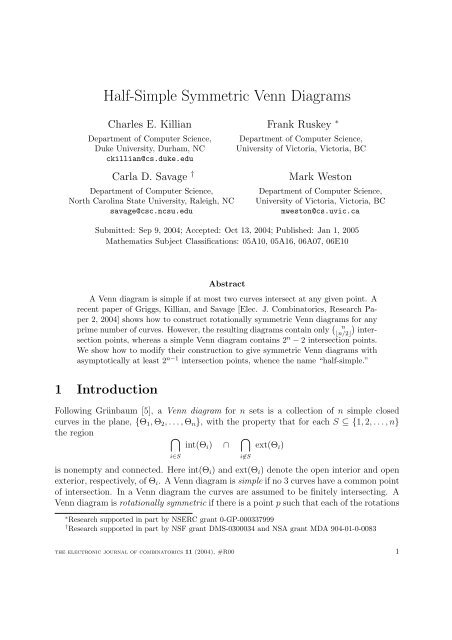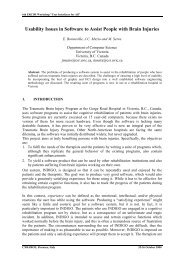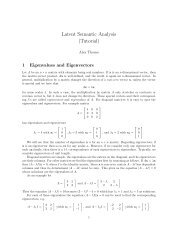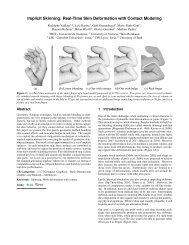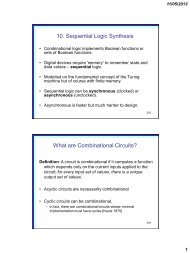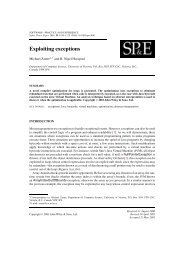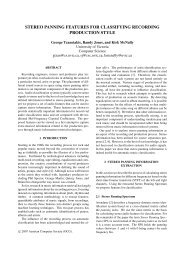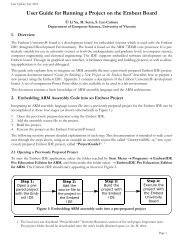Half-Simple Symmetric Venn Diagrams - Computer Science ...
Half-Simple Symmetric Venn Diagrams - Computer Science ...
Half-Simple Symmetric Venn Diagrams - Computer Science ...
Create successful ePaper yourself
Turn your PDF publications into a flip-book with our unique Google optimized e-Paper software.
0000001000 00100000100000101010 0100100110 00101 00011Figure 1: The rooted tree T 5 of 5-bit strings with no unmatched 1.As an example, by this rule node 00100 in T 5 is expanded into the chain C 00100 :C 00100 : 00100 → 10100 → 10110 → 10111and the complete list of chains for nodes in T 5 is:C 00000 : 00000 → 10000 → 11000 → 11100 → 11110 → 11111C 01000 : 01000 → 01100 → 01110 → 01111C 01010 : 01010 → 01011C 01001 : 01001 → 01101C 00100 : 00100 → 10100 → 10110 → 10111C 00110 : 00110 → 00111C 00101 : 00101 → 10101C 00010 : 00010 → 10010 → 11010 → 11011C 00011 : 00011 → 10011C 00001 : 00001 → 10001 → 11001 → 11101Greene and Kleitman showed in [3] that this gives a symmetric chain decomposition ofthe Boolean lattice. That is, (1) each of the resulting paths in the n-cube is a chain inB n : each element is covered in B n by its successor; (2) in each chain, the weights of thefirst and last elements sum to n; and (3) every n-bit string is in exactly one of the chains.By definition of T n , the first elements of C x and C p(x) differ in only one bit. In [4] itis shown that the last elements of C x and C p(x) also differ in only one bit and the chainsare used to get a <strong>Venn</strong> diagram as follows.We use the chain decomposition derived from T n to build a plane graph P (T n ) thatforms the dual of the final <strong>Venn</strong> diagram. Embed the chains {C x |x ∈ T n } vertically inthe plane, one unit apart and centered about some horizontal line, by preorder in T n ; thatis, (1) for every x, C x precedes C y if y is a descendant of x in T n and (2) regarding thechildren of x as ordered x 1 , ..., x t for 1 ≤ i ≤ t − 1, chains for descendants of x i mustappear before chains for descendants of x i+1 . (See Figure 2, ignoring the green edges).In addition, for each x of positive weight, whenever x is the first child of its parent p(x)we include the edge joining the first elements of C x and C p(x) and the last elements of C xthe electronic journal of combinatorics 11 (2004), #R00 4
1111111110011111011111011111011110001110 01011 01101 101100011110101110101001111001110000110001010 0100110100 0011000101100100001110001100000100000100000100000100000Figure 2: The plane graph P (T 5 ), with attaching edges drawn in green.and C p(x) (these edges must always exist, as noted above). Henceforth we refer to theseedges, shown as the green edges in Figure 2, as the attaching edges for C x .As shown in [4], the resulting graph P (T n ) is a plane, monotone, spanning subgraph ofthe n-cube, so by Theorem 1, its dual is a <strong>Venn</strong> diagram. Figure 3 illustrates the processof taking the dual of P (T 4 ), and Figure 4 shows the resulting <strong>Venn</strong> diagram for 4 sets. Inthis construction, the number of vertices in the resulting <strong>Venn</strong> diagram will be the sameas the number of chains in the symmetric chain decomposition of the Boolean lattice B n ,which is ( n⌊n/2⌋).Moving now to prime n, the notion of block code for strings under rotation was introducedin [4] and was the key breakthrough in showing the existence of symmetric <strong>Venn</strong>diagrams for all prime n. Define the block code β(x) of a binary string x as follows. If xstarts with 0 or ends with 1, then β(x) = (∞). Otherwise, x can be written in the form:x = 1 a 10 b 11 a 20 b2 · · · 1 a t0 b tfor some t > 0, where a i > 0, b i > 0, 1 ≤ i ≤ t, in which case,β(x) = (a 1 + b 1 , a 2 + b 2 , . . . , a t + b t ).The n rotations of x, where x has length n, are the n strings reachable by applyingthe circular permutation (12 · · · n) to x. As an example, the block codes of the string1110101100010 and all of its rotations are shown below.the electronic journal of combinatorics 11 (2004), #R00 5
{1,2,3,4}{1,2,4}{1,2,3}{2,3,4}{1,3,4}{1,2}{2,3}{2,4}{1,3}{3,4}{1,4}{3}{1}{2}{4}{}Figure 3: Construction of dual of P (T 4 ).{1,2,3,4}{1,2,4}{1,2,3}{2,3,4}{1,3,4}{1,2}{2,3}{2,4}{1,3}{3,4}{1,4}{3}{1}{2}{4}{}Figure 4: <strong>Venn</strong> diagram for n = 4.the electronic journal of combinatorics 11 (2004), #R00 6
1000000101000010010001010100 1001100Figure 5: The rooted tree S 7 of 7-bit rotational equivalence class representatives with oneunmatched 1.bit string block code bit string block code1110101100010 (4, 2, 5, 2) 1100010111010 (5, 2, 4, 2)0111010110001 (∞) 0110001011101 (∞)1011101011000 (2, 4, 2, 5) 1011000101110 (2, 5, 2, 4)0101110101100 (∞) 0101100010111 (∞)0010111010110 (∞) 1010110001011 (∞)0001011101011 (∞) 1101011000101 (∞)1000101110101 (∞)When n is prime, every n-bit string, other than 00 · · · 00 and 11 · · · 11, has n distinctrotations. Similarly, it is shown in [4] that when n is prime, no two different rotationsof an n-bit string can have the same finite block code. Assuming that block codes areordered lexicographically, in each equivalence class of n-bit strings under rotation, theunique string with minimum block code can be chosen as the representative.For prime n, define the rooted tree S n to be the tree whose nodes are the n-bit stringsx with exactly one unmatched 1 and with β(x) ≤ β(y) for any rotation y of x. Note thatthe unmatched 1 must appear in the leftmost position of x. The parent of node x, p(x),is obtained from x by changing the last 1 in x to 0. We note that p(x) is in S n when xis, since it is shown in [4] that (i) if x has exactly one unmatched 1, the same is true forp(x) and (ii) if β(x) is minimal under all rotations of x, then β(p(x)) is also. See Figure5 for S 7 .Given S n , we now grow each node x of S n into a chain C x of n-bit strings using thefollowing variation of the Greene-Kleitman construction[3]:Start with a string x which has one unmatched 1 and lexicographically smallestblock code among all of its rotations (i.e., a node in S n ). If there is more thanone unmatched 0 in x, change the first unmatched 0 to 1 to get its successor,y. If there is more than one unmatched 0 in y, change the first unmatched 0in y to 1 to get its successor. Continue until a string with only one unmatched0 is reached.the electronic journal of combinatorics 11 (2004), #R00 7
3 Quadrangulating FacesIn this section we show that in the chain graph, P (T n ), any face formed by a chain andits first child can be quadrangulated (i.e. decomposed into faces bordered by 4 edges,that is, 4-faces) by adding non-crossing edges of the n-cube. Quadrangulating all suchfaces results in a plane monotone spanning subgraph Q(T n ) of the n-cube. By Theorem1, the dual of Q(T n ), Q(T n ) ∗ , is a <strong>Venn</strong> diagram. Since Q(T n ) has more faces thanP (T n ), the <strong>Venn</strong> diagram Q(T n ) ∗ has more vertices than P (T n ) ∗ . Similarly, for prime nwe show that in the chain graph P (S n ), any face formed by a chain and its first childcan be quadrangulated by adding non-crossing edges of the n-cube and use this to geta symmetric <strong>Venn</strong> diagram with more vertices. In Sections 4 and 5 we count how manyvertices are added to the <strong>Venn</strong> diagrams which result from quadrangulating these facesin P (T n ) and P (S n ).Let |C| denote the length of a chain C, that is, its number of edges.Theorem 2 Let w ≠ 0 n be a node in T n and let x be its parent. If chains C x , C w areembedded consecutively in P (T n ), the face bounded by the chains C w , C x , and the attachingedges of C x can be quadrangulated into |C w | + 1 4-faces by adding |C w | edges of the n-cube(as shown in Figure 7).Proof. Since w is a node of T n , w has no unmatched 1. Let b be the position of the last1 in w and let a be the position of the 0 to which it is matched. Then w has the formw = y10 n−b and x = y0 n−b+1 . Note (i) that a < b and w has no unmatched 0 between aand b (else the 1 in position b would have preferred it to the 0 in position a.) Also note(ii) that in x position a and b both contain unmatched 0 bits (there is no 1 to the right ofb in x; in w, no 1 in y matched to the 0 in position a, so this remains true in x.) Finally,note (iii) that if U 0 (y) denotes the set of positions of the unmatched 0 bits in a string y,then U 0 (x) is the disjoint union U 0 (x) = U 0 (w) ∪ {a, b}.Let U 0 (w) = {u 1 , u 2 , . . . . . . u m }, where u 1 < u 2 < · · · < u m . By (i) above, there existsi, 0 ≤ i ≤ m such that u 1 < u 2 < · · · < u i < a < b < u i+1 < · · · < u m . By (iii),U 0 (x) = {u 1 , u 2 , . . . , u i , a, b, u i+1 , u i+2 , . . . , u m }.For S ⊆ {1, . . . , n}, Define I S to be the n-bit string with i-th bit ‘1’ iff i ∈ S. Thenthe chain grown from w by the Greene-Kleitman successor rule (change first unmatched0 to 1) is the chain of length m:C w :C w (0), C w (1), . . . , C w (m),where C w (0) = w and for 1 ≤ j ≤ m,C w (j) = w + I {u1 ,u 2 ,...,u j }.Here ‘+’ denotes bitwise or. The chain grown from x is:C x : C x (0), C x (1), . . . , C x (m + 2),the electronic journal of combinatorics 11 (2004), #R00 10
C x (m + 2)aC x (m + 1)u mau mC w (m)C w (m − 1)C x (i + 3)aC x (i + 2)C x (i + 1)u i+1baC w (i + 1)u i+1C w (i)abC x (i)bu 2C w (2)C x (2)u 2bu 1C w (1)C x (1)u 1bC w (0) = wC x (0) = xFigure 7: Quadrangulation of the face bordered by the chain C w , its parent chain C x , andthe two attaching edges.the electronic journal of combinatorics 11 (2004), #R00 11
1111111110011111011111011111011110001110 01011 01101 101100011110101110101001111001110000110001010 0100110100 0011000101100100001110001100000100000100000100000100000Figure 8: The plane graph P (T 5 ) with quadrangulated faces.where⎧x if j = 0⎪⎨x + IC x (j) ={u1 ,u 2 ,...,u j } if 1 ≤ j ≤ ix + I ⎪⎩ {u1 ,u 2 ,...,u j−1 } + I {a} if j = i + 1x + I {u1 ,u 2 ,...,u j−2 } + I {a,b} if i + 2 ≤ j ≤ m + 2Then for 0 ≤ j ≤ i, C w (j) and C x (j) are adjacent in the n-cube, since they differ onlyin bit b, where w and x differ. For i ≤ j ≤ m, C w (j) and C x (j + 2) are adjacent in then-cube: they differ only in bit a, sinceC x (j + 2) = x + I {u1 ,u 2 ,...,u j } + I {a,b} = w + I {u1 ,u 2 ,...,u j } + I {a} = C w (j) + I {a} .Finally, if chains C x , C w are embedded consecutively in P (T n ), the m edges(C x (1), C w (1)), (C x (2), C w (2)), . . . , (C x (i), C w (i)), (C x (i + 2), C w (i)),(C x (i + 3), C w (i + 1)), . . . , (C x (m + 1), C w (m − 1))can be added without crossings to create m + 1 faces interior to the original face. ✷Figure 8 shows the plane graph that results if all faces of P (T 5 ) bounded by chainscorresponding to a node and its first child in T 5 are quadrangulated; the added edges areshaded in the figure.We get a similar result for the plane graph P (S n ).Theorem 3 Let w ≠ 10 n−1 be a node in S n and let x be its parent. If chains C x , C ware embedded consecutively in P (S n ), the face bounded by the chains C w , C x , and theattaching edges of C x can be quadrangulated into |C w | + 1 4-faces by adding |C w | edges ofthe n-cube.the electronic journal of combinatorics 11 (2004), #R00 12
111111011111001011110110111011110001011100101011011011001001110111000010110001010100110100010011001100000101000010010001000000Figure 9: The plane graph P (S 7 ) with quadrangulated faces.Proof. The same proof works as for Theorem 2 after observing that for Theorem 3, ifU 0 (w) = {u 1 , u 2 , . . . u m }, then C w is the chain:C w : C w (0), C w (1), . . . , C w (m − 1).✷Figure 9 shows the plane graph that results if all faces of P (S 7 ) bounded by chainscorresponding to a node and its first child in S 7 are quadrangulated; the added edges areshaded in the figure.4 <strong>Half</strong>-<strong>Simple</strong> <strong>Venn</strong> <strong>Diagrams</strong> for All nIn this section we show that in P (T n ), quadrangulating every face corresponding to anode and its first child gives a <strong>Venn</strong> diagram with 2 n−1 vertices. Since quadrangulatingpreserves the property that P (T n ) is a plane, monotone, spanning subgraph of the n-cube,the dual is still a <strong>Venn</strong> diagram. It remains only to count the number of faces added toP (T n ) by quadrangulating.We make the following definitions.• Let N n be the total number of nodes in T n . Each node corresponds to one chainin the symmetric chain decomposition of B n , and the number of chains is just thenumber of elements at the middle level of B n : N n = ( n⌊ n 2 ⌋ ).• Let N n (d) denote the number of nodes of weight d in T n . (Nodes of weight d areat depth d in T n .) Then N n (d) = 0 if d ≥ ⌊ n ⌋. Since the chain starters at level d2the electronic journal of combinatorics 11 (2004), #R00 13
in the Boolean lattice are those strings of weight d which do not belong to chainsstarted by strings of smaller weight, we have⎧ ( n(⎨ d)−n)d−1 0 < d ≤ ⌊n⌋ , 2N n (d) = 1 if d = 0,(2)⎩0 otherwise.Note that ( ) (nd − n) (d−1 =n−2d+1 n)n−d+1 d is a member of the well-studied set of “ballotnumbers”.• Let L n (d) denote the number of nonleaves of weight d in T n .If a node x has a child in T n , and if w is its first child, then in the plane graph P (T n ),C w is embedded immediately to the right of C x . By Theorem 2, we can add |C w | = |C x |−2edges to P (T n ) to quadrangulate the face bounded by C x , C w , and the attaching edges ofC w . Thus for every non-leaf node x in T n , chain C x is the left boundary of a face in P (T n )that can be quadrangulated to add |C x | − 2 extra faces to P (T n ). We wish to count thenumber F n of such faces added:∑F n =(|C x | − 2). (3)nonleaf nodes x in T nObserve that if x ∈ N n (d), then |C x | = n − 2d, since |C 0 n| = n and for y ≠ 0 n in T n ,|C p(y) | = |C w | + 2. Then⌊ n 2 ⌋∑F n = (n − 2d − 2)L n (d). (4)d=0Our goal is to show that F n = 2 n−1 − ( )n⌊ . We first need to be able to compute n Ln (d).2 ⌋Lemma 1 If n > 1 and 0 ≤ d ≤ ⌊ n−1⌋,then L 2 n(d) = ( ) (n−1d − n−1d−1), and 0 otherwise.Proof. We show that L n (d) = N n−1 (d) by showing that the mapping f(x) = x0 is abijection from the set of nodes in T n−1 of weight d to the set of non-leaves in T n of weightd. The result follows then from (2).If x is a node of weight d in T n−1 , x has no unmatched 1, so neither does x0, so x0 isa node of weight d in T n . To see that x0 is a nonleaf, note that since 2d < n, x has anunmatched 0, so x1 is in T n and p(x1) = x0. Clearly f is one-to-one. To see that f isonto, let y be a nonleaf node of weight d in T n . Then y has a child z and z has the formz = α10 i for some i ≥ 0. Since z is in T n , α has no unmatched 1 and y = p(α10 i ) = α0 i+1 .Thus, α0 i is in T n−1 and y = f(α0 i ).✷Lemma 2 For n ≥ 2,⌊ n 2 ⌋∑L n (d) =d=0( ) n − 1⌊ n⌋ − 1 .2the electronic journal of combinatorics 11 (2004), #R00 14
Proof. Note that the summand is 0 if d = ⌊n/2⌋. Applying Lemma 1 gives a telescopingsum.✷Lemma 3 For n ≥ 2,⎧⌊∑n 2 ⌋ ⎪⎨dL n (d) =d=0 ⎪⎩( )n n − 1n2 − 1 − 2 n−22 ( )n − 1 n − 12 ⌊ n⌋ − 1 + 1 22( ) n − 1⌊ n⌋ − 2 n−22if n is evenif n is odd.Proof. First note that the summand is 0 when d = 0 or d = ⌊ n ⌋ and then apply Lemma21 to get⌊ n 2 ⌋∑dL n (d) =d=0=⌊ n 2 ⌋−1 ∑d=1⌊ n 2 ⌋−1 ∑d=1(( ) n − 1d −d(d( )) n − 1d − 1( ) ( ))n − 1n − 1− (d − 1) −dd − 1⌊ n 2 ⌋−1 ∑d=1(5)( ) n − 1. (6)d − 1The first sum telescopes, giving (⌊ n⌋ − 1)( )n−12 ⌊ . The second sum is the number ofn2 ⌋−1elements in the first ⌊ n⌋ − 2 levels of the Boolean lattice B 2 n−1 which, when n is even, is:( ( ))1n − 12 n−1 − 22⌊ n⌋ − 1 ,2and when n is odd:( ( ) ( ))1n − 1 n − 12 n−1 − 22⌊ n⌋ − 1 −⌊ n⌋ .2 2✷Theorem 4 For all n ≥ 2, the number of faces in the plane graph P (T n ) after quadrangulatingis 2 n−1 . Thus, there are 2 n−1 vertices in its dual, which is a <strong>Venn</strong> diagram for nsets.Proof. The embedding of the chain cover graph has ( n⌊n/2⌋)faces. We show that thenumber of such edges added in the quadrangulation phase is F n = 2 n−1 − ( n⌊n/2⌋). By (4),⌊ n 2 ⌋∑∑ ∑F n = (n − 2d − 2)L n (d) = (n − 2) L n (d) − 2 dL n (d). (7)d=0⌊ n 2 ⌋d=0Using Lemmas 2 and 3, when n is even (7) becomes( ) ( )n − 1n − 1(n − 2)n− 1 + 2 n−1 − nn− 1 = 2 n−1 − 22 2( n − 1⌊ n 2 ⌋d=0) ( ) nn− 1 = 2 n−1 −n.2 2the electronic journal of combinatorics 11 (2004), #R00 15
When n is odd (7) becomes( )( ) ( )n − 1n−1 n − 1(n−2)⌊ n⌋−1 +2 n−1 −(n−1)⌊ n⌋−1 −⌊ n⌋ 2 2 2( n−1= 2 n−1 −( n= 2 n−1 −⌊ n 2 ⌋ − 1 )−⌊ n 2 ⌋ ).( ) n−1⌊ n⌋ 2✷This number is one more than half the number of vertices in a simple diagram of ordern. Thus we propose to call these diagrams “half-simple”.5 At Least <strong>Half</strong>-<strong>Simple</strong> <strong>Symmetric</strong> <strong>Diagrams</strong>for Prime nRecall that in Section 2, for prime n, the plane graph R(P (S n )) was created from ncopies of P (S n ) and the dual of R(P (S n )) was a symmetric <strong>Venn</strong> diagram with ( )n⌊n/2⌋vertices. By Theorem 3, we can quadrangulate every face corresponding to a node andits first child in S n in every copy of P (S n ) and the resulting quadrangulation of R(P (S n ))is still a plane, monotone, symmetric, spanning subgraph of the n-cube; thus its dual isstill a symmetric <strong>Venn</strong> diagram. In this section we show that the total number of facesin the quadrangulation of R(P (S n )) is at least 2 n−1 (1 − o(1)) and therefore its dual isasymptotically at least half-simple.As an example for n = 11 (see Figure 10), the number of faces of P (S 11 ) beforequadrangulating is ( )115 /11 = 42. The number of faces added by quadrangulating thefaces between the chains corresponding to a node in S 11 and its first child is 69. Repeatingthis in every copy of P (S 11 ), the total number of faces in the resulting quadrangulationof R(P (S 11 )) is 11(42+69)=1221. In addition, note that any circular permutation canbe used to label subsequent rotated copies of P (S 11 ); if the circular permutation used is(6 7 8 9 10 11 1 2 3 4 5), then 16 extra faces can be added to P (S 11 ) by manually addingextra edges wherever possible, giving another 11 × 16 = 171 faces in the graph. Thus, thedual is a symmetric <strong>Venn</strong> diagram with 1221+171 = 1392 vertices, whereas a simple <strong>Venn</strong>diagram would have 2046 vertices. This diagram is rigid, i.e. as simple as possible, as nomore edges can be added to the dual graph and thus no more vertices can be separatedin the <strong>Venn</strong> diagram.For contrast, in [6], Hamburger shows how to separate vertices in his 11-<strong>Venn</strong> diagramfrom [7] to get symmetric 11-<strong>Venn</strong> diagrams with only up to 1001 vertices. Following hisexample, we can say that since each of the 69 + 16 = 85 extra edges can either be presentor not in the rotated copies of P (S 11 ), these extra edges give us 2 85 distinct symmetric11-<strong>Venn</strong> diagrams, more than previously known.It remains to count F n , the number of faces added to P (S n ) by quadrangulating thefaces between the chains corresponding to a node in S n and its first child. Then nF n isthe total number of faces added to R(P (S n )).Recall from Section 2 that x is a node in S n if and only ifthe electronic journal of combinatorics 11 (2004), #R00 16
¡¢ £¡¢ £(a) After quadrangulating all faces corresponding to a node in S 11 and its first child.(b) After manually adding extra edges, including wrapping edges.Figure 10: Adding edges to the graph P (S 11 ).• (i) x has finite block code (so it starts with 1 and ends with 0),• (ii) β(x) ≤ β(σ i (x)) for any i, and• (iii) x has exactly one unmatched 1.We will make use of the following lemma:Lemma 4 If x is a node in the chain cover tree and if the last block of x has the form10 k , then k ≥ 2.Proof. First, k ≥ 1 as β(x) is finite. If k = 1, then β(x) = (. . . , 2). However as n = |x|is prime there must be an element in β(x), call it j, such that j ≥ 3 and so we couldcreate a rotation of x with a lexicographically smaller block code by rotating two positionsright to create x ′ with β(x ′ ) = (2, . . .). This contradicts the fact that x has the (unique)lexicographically lowest block code of all of its rotations.✷Let l(x) denote the location of the last 1 in x.Theorem 5 If u and v are children of w in the chain cover tree and l(u) < l(v), then vis not a leaf.the electronic journal of combinatorics 11 (2004), #R00 17
Proof. Since w satisfies (i), w can be written asw = α1 a 0 b ,where either α is empty or α has finite block code. Then u and v have the formu = α1 a 0 c 10 b−c−1 ; v = α1 a 0 c′ 10 b−c′ −1 ,where 0 ≤ c = l(u) − |α| − a − 1 and c < c ′ = l(v) − |α| − a − 1. Letz = α1 a 0 c′ 110 b−c′ −2 .If we show that z satisfies (i)-(iii), then z is a child of v in the chain cover tree.Applying Lemma 4 to v gives that b − c ′ − 2 ≥ 2, so z ends in 0 and starts with 1,satisfying (i). Also β(z) = β(v), so z satisfies (ii). Finally, since u is a node, it satisfies(iii) and therefore the following string has exactly one unmatched 1, which, since c ≥ 1,is not the last 1:α1 a 0 c 1.Then, since c ′ > c, the stringα1 a 0 c′ 1has exactly one unmatched 1 and at least one unmatched 0, so the stringα1 a 0 c′ 11(and therefore also z) has exactly one unmatched 1. So z satisfies (iii).✷Corollary 1 Each node in the chain cover tree has at most one leaf child.We make the following definitions.• Let N(d) denote the number of nodes of weight d in S n . Then N(1) = 1 and ford > 1,N(d) = 1 [( ( )]n n− , (8)n d)d − 1• Let L(d) denote the number of leaves of weight d in S n .• Let L(d) denote the number of nonleaves of weight d in S n .• Let w(d) denote the number of faces added to P (S n ) by quadrangulating the regionbetween the chains corresponding to a node x of weight d its first child w in S n .¿From Theorem 2 we know thatw(d) = |C w | = |C x | − 2 = n − 2d − 2 for 1 ≤ d ≤ (n − 3)/2. (9)the electronic journal of combinatorics 11 (2004), #R00 18
Then F n , the number of faces added to P (S n ), can be expressed asF n =(n−3)/2∑d=1w(d)L(d).We can get a lower bound on F n by observing first that every node at level d contributeseither w(d − 1) toward quadrangulating a region with its parent (if it is a leaf) or w(d)toward quadrangulating a region with its first child (if it is a nonleaf) or both. ByCorollary 1, leaves can be mapped one-to-one to parents. Thus if we count all of thecontributions at every node at every level, we are at worst double-counting, giving thesecond inequality below. The first inequality follows since w(d) ≤ w(d − 1) and N(d) =L(d) + L(d).(n−3)/2∑d=1w(d)N(d) ≤∑(n−3)/2d=1(w(d − 1)L(d) + w(d)L(d) ≤ 2(n−3)/2∑Thus, the number of faces added to R(P (S n )) by quadrangulating isnF n ≥ n 2(n−3)/2∑d=1d=1L(d)w(d).w(d)N(d). (10)Theorem 6 For n prime, the number of faces added to R(P (S n )) by quadrangulating isnF n ≥ 2 n−1 − 1 − 1 [( ) ( )]n + 1n+, (11)2 (n + 1)/2 (n − 3)/2making its dual a symmetric <strong>Venn</strong> diagram with 2 n−1 (1 − o(1)) vertices.Proof. We need to show that (11) is a lower bound for (10).We will make use of the following identity, established in the proof of Theorem 4, withthe observation that in (7), L(⌊ n ⌋) = 0.2∑[( ) n − 1(n − 2d − 2) −d⌊ n 2 ⌋−1d=0( )] ( )n − 1n= 2 n−1 − . (12)d − 1⌊n/2⌋If we replace n by n + 1 and observe that the summand on the left is n − 1 when d = 0then for odd n, we get∑(n+1)/2−1d=1[( n(n − 2d − 1) −d)( )] ( )nn + 1= 2 n −− (n − 1). (13)d − 1(n + 1)/2the electronic journal of combinatorics 11 (2004), #R00 19
Starting from (10) and using (8) and (9),⎛(n−3)/2n ∑w(d)N(d) = n ∑⎝(n−4) +22d=1d=2⎛(n−3)/2(n−2d−2) 1 n= 1 ⎝n(n−4)−(n−1)(n−4) +2⎛= 1 ⎝n−4+2⎛= 1 ⎝n−4+2∑(n−3)/2d=1−∑(n−3)/2d=1(n−2d−1)(n−3)/2∑d=1∑(n−3)/2d=1[( ( )] n n−d)⎞ ⎠d−1(n−2d−2)[( ( )]n n−d)d−1[( ( )] n n−d)⎞ ⎠d−1[( ( )] n n−d)⎞ ⎠d−1⎞[( ( )] ( )n nn(n−2d−1) − −+1⎠ .d)d−1 (n−3)/2We now make use of (13) to evaluate the sum in the last line above, noting that the lastterm in the sum on the left of (13) is 0:(n−3)/2n ∑w(d)N(d) = 1 22d=1(( n + 1n − 4 + 2 n −(n + 1)/2= 2 n−1 − 1 − 1 2(( n + 1(n + 1)/2)( )n− (n − 1) −(n − 3)/2) ( ))n+.(n − 3)/2)+ 1This lower bound asymptotically approaches 2 n−1 as n increases.✷In fact, the number of faces resulting from the quadrangulations appears to be considerablylarger than the lower bound given by the theorem, but we have been unable tofind a tighter counting argument which would establish this. The table below shows acomparison of the number of vertices in a simple <strong>Venn</strong> diagram, the number of vertices inthe symmetric <strong>Venn</strong> diagrams produced by the GKS construction, the number of verticesin the symmetric <strong>Venn</strong> diagrams produced by the construction of this paper (KRSW), andthe ratio of the number of vertices produced by the KRSW construction to the numberin a simple <strong>Venn</strong> diagram.the electronic journal of combinatorics 11 (2004), #R00 20
[KRSW]simplen simple [GKS] [KRSW]3 6 3 3 .50005 30 10 15 .50007 126 35 70 .555611 2,046 462 1,221 .596813 8,190 1,716 5,005 .611117 131,070 24,310 81,787 .624019 524,286 92,378 329,289 .628123 8,388,606 1,352,078 5,308,423 .63286 Concluding RemarksWe have succeeding in showing that for prime n there are symmetric <strong>Venn</strong> diagrams thatare nearly simple, in the sense that the average number of curves passing through a pointof intersection is at most a constant c, independent of n. Although we have established thisfor (asymptotically) c = 4, the same construction with an improved counting argumentcould likely lower the constant c. The question remains as to whether there are simplesymmetric <strong>Venn</strong> diagrams for n prime and greater than 7; even the the n = 11 caseremains open.It would also be interesting to prove an upper bound on the number of symmetric<strong>Venn</strong> diagrams.References[1] Bette Bultena, Branko Grünbaum, and Frank Ruskey. Convex drawings of intersectingfamilies of simple closed curves. In 11th Canadian Conference on ComputationalGeometry, pages 18–21, 1999.[2] Bette Bultena and Frank Ruskey. <strong>Venn</strong> diagrams with few vertices. Electron. J.Combin., 5(1):Research Paper 44, 21 pp. (electronic), 1998.[3] Curtis Greene and Daniel J. Kleitman. Strong versions of Sperner’s theorem. J.Combinatorial Theory Ser. A, 20(1):80–88, 1976.[4] Jerrold Griggs, Charles E. Killian, and Carla D. Savage. <strong>Venn</strong> diagrams and symmetricchain decompositions in the Boolean lattice. Electron. J. Combin., 11:Research Paper2, 30 pp. (electronic), 2004.[5] Branko Grünbaum. <strong>Venn</strong> diagrams and independent families of sets. Math. Mag.,48:12–23, 1975.[6] Peter Hamburger. Pretty drawings. More doodles and doilies, symmetric<strong>Venn</strong> diagrams. Utilitas Mathematica. To appear, preprint(http://www.ipfw.edu/math/hamburger/papers.htm).the electronic journal of combinatorics 11 (2004), #R00 21
[7] Peter Hamburger. Doodles and doilies, non-simple symmetric <strong>Venn</strong> diagrams. DiscreteMath., 257(2-3):423–439, 2002.[8] D. W. Henderson. <strong>Venn</strong> diagrams for more than four classes. American MathematicalMonthly, 70:424–426, 1963.[9] Frank Ruskey. A survey of <strong>Venn</strong> diagrams. Electron. J. Combin., 4(1):Dynamic Survey5 (electronic), 2001.the electronic journal of combinatorics 11 (2004), #R00 22


